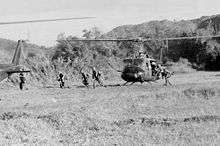Robert Mason (writer)
| Robert Mason | |
|---|---|
| Nickname(s) | "Bob" |
| Born | March 20, 1942 |
| Allegiance | United States of America |
| Service/branch | United States Army |
| Years of service | 1964–1968 |
| Rank | Warrant Officer 1 |
| Unit | 229th Assault Helicopter Battalion, 1st Cavalry Division (Airmobile) 48th Aviation Co. Vietnam |
| Battles/wars |
|
Robert C. Mason (born March 20, 1942) is a Vietnam War veteran and author of several books, including his first, best-selling memoir: Chickenhawk (1983). Mason piloted Huey "Slicks" in the United States Army as a Warrant Officer 1. He sailed to Vietnam with the 1st Cavalry Division (Airmobile) and served a one-year tour, nine months with the "First Cav", the last three months with the 48th Aviation Company.[1]

After an initial month of living in a pup tent, chopping stumps to clear land for the airbase but doing very little flying, things started to pick up. Company B, 229th was involved in the Battle of Ia Drang. Mason and his fellow pilots flew many missions to resupply the infantry and pick up wounded, since at that time Cav Medevac helicopters were not allowed to fly if the landing zone (LZ) was hot. In gripping detail, Mason provides accounts of many of their missions and battles, including the Battle of Bong Son and Happy Valley in Chickenhawk. He also gives the reader an idea of the complexities of flying a helicopter and the unique demands of being a helicopter pilot in combat.[1]
Mason transferred to the 48th Aviation Company (United States) in May 1966, although he called it the 49th in the book. He continued to fly helicopters, including assault missions for the 101st Airborne in Dak To as part of Operation Hawthorne in June 1966. Mason carried out other flying tasks and tells funny stories about life in the 48th including flying drunk and trading for block ice.[1]
After his one-year tour of duty, Mason became an instructor pilot at Fort Wolters, Texas. Eventually he was grounded for dizzy spells and diagnosed with combat fatigue resulting from his service in Vietnam. Combat fatigue was later renamed posttraumatic stress disorder.[2]
In 1979, Mason began to write a book about his tour in Vietnam. He named it Chickenhawk, after a conversation he and his friend and fellow helicopter pilot Jerry Towler had had in 1965 while waiting to pick up some GIs in Vietnam. The two were describing their alternating feelings of terror and courage as they flew missions.
In 1981, Mason was arrested for smuggling marijuana on a boat from Colombia.[3] A month later his agent sold Chickenhawk to Viking Penguin based on the one third of the book Mason had delivered. Mason didn't tell anyone of his arrest, including his agent and his editor, until they finished the rest of the book and read the last page.[2]
Chickenhawk was published in 1983, and Christopher Lehmann-Haupt gave it a stunning review in The New York Times. Mason was invited to appear on the The Today Show on a Wednesday and had to show up at Eglin Federal Prison Camp on the following Friday. Chickenhawk became a hardcover and paperback best-seller. It was given rave reviews all over the country which inspired People magazine to do a story on his troubles under the heading "Trouble."
Mason was released from prison on May 17, 1985. He has subsequently published two novels, Weapon and Solo, as well as a second memoir, Chickenhawk: Back in the World. In 1996, Columbia/Tristar released a film (Solo) based on Mason's first novel, but which used the title of the second.
Bibliography
- Chickenhawk (1983) ISBN 0-670-21582-1
- Solo series (the 1996 film is based on the first book):
- Introduction to Recovering from the War, by Patience H.C. Mason (1990) ISBN 0-14-009912-3
- Chickenhawk: Back in the World: Life After Vietnam (1993) ISBN 0-670-84835-2
References
- 1 2 3 Mason, Robert (1983). Chickenhawk. Viking-Penguin. ISBN 0-14-007218-7.
- 1 2 Mason, Robert (1993). Chickenhawk: Bsck in the World. Viking-Penguin. ISBN 0-670-84835-2.
- ↑ Chandler, David (September 12, 1983). "Author Robert Mason, Jailed for Drug Running, Watches His Literary Triumph, Chickenhawk, Fly the Coop". People.com. 20 (11). Retrieved 21 November 2011.
External links
- Robert C. Mason website
- UH-1 63-3794 helicopter flown by Robert Mason, restored and on display at U.S. Veterans Memorial Museum, Huntsville, Alabama